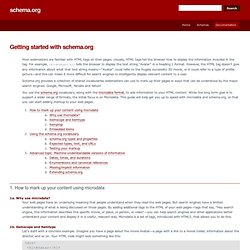

Schema.org vs data-vocabulary.org. Getting Started. Most webmasters are familiar with HTML tags on their pages.

Usually, HTML tags tell the browser how to display the information included in the tag. For example, <h1>Avatar</h1> tells the browser to display the text string "Avatar" in a heading 1 format. However, the HTML tag doesn't give any information about what that text string means—"Avatar" could refer to the hugely successful 3D movie, or it could refer to a type of profile picture—and this can make it more difficult for search engines to intelligently display relevant content to a user. Schema.org provides a collection of shared vocabularies webmasters can use to mark up their pages in ways that can be understood by the major search engines: Google, Microsoft, Yandex and Yahoo! You use the schema.org vocabulary, along with the microdata format, to add information to your HTML content. 1. 1a.
Your web pages have an underlying meaning that people understand when they read the web pages. 1b. itemscope and itemtype Back to top. Documentation. Data Model. The following is a discussion about the data model used by schema.org. The data model used is very generic and derived from RDF Schema (which in turn was derived from CycL, which in turn ...). We have a set of types, arranged in a multiple inheritance heirarchy where each type may be a sub class of multiple types.
We have a set of properties each property may have one or more types as its domains. The property may be used for instances of any of these types. Each property may have one or more types as its ranges. The decision to allow multiple domains and ranges was purely pragmatic. Like many other systems, the schema presented here can be extended (with a few types like Type and Property and a few properties like domainIncludes and rangeIncludes) to allow for reflection, i.e., for the schema to be represented in terms of itself. The canonical machine representation of schema.org is in RDFa: Full Hierarchy. Place. Indicates a page (or other CreativeWork) for which this thing is the main entity being described.

Many (but not all) pages have a fairly clear primary topic, some entity or thing that the page describes. For example a restaurant's home page might be primarily about that Restaurant, or an event listing page might represent a single event. The mainEntity and mainEntityOfPage properties allow you to explicitly express the relationship between the page and the primary entity.
Related properties include sameAs, about, and url. The sameAs and url properties are both similar to mainEntityOfPage. MainEntityOfPage can be used for any page, including those not recognized as authoritative for that entity. About is similar to mainEntity, with two key differences. Product. Rich Snippets & Microdata Generator. Product. Canonical URL: Thing > Product Any offered product or service.

For example: a pair of shoes; a concert ticket; the rental of a car; a haircut; or an episode of a TV show streamed online. Usage: Over 1,000,000 domains Instances of Product may appear as values for the following properties More specific Types Acknowledgement This term uses terminology from the GoodRelations Vocabulary for E-Commerce, created by Martin Hepp. Examples <div> <! <div itemscope itemtype=" <link itemprop="url" href=" /> <span itemprop="numberOfItems">315</span> <div itemprop="itemListElement" itemscope itemtype=" <img alt="Photo of product" itemprop="image" src=" /> <a itemprop="url" href=" <span itemprop="name">BRAND 502</span> </a> <div itemprop="offers" itemscope itemtype=" <span itemprop="price">4399 р. Person. Canonical URL: Thing > Person A person (alive, dead, undead, or fictional).

Usage: Over 1,000,000 domains Instances of Person may appear as values for the following properties More specific Types available in extensions Patient Acknowledgement This class contains derivatives of IPTC rNews properties. rNews is a data model of publishing metadata with serializations currently available for RDFa as well as HTML5 Microdata. Examples An example of a invoice for a purchase and installation.ACME Home HeatingBill for: New furnace and installationCustomer: Jane Doepayment due: 2015-01-30minimum payment: $0.00total due: $0.00payment status: paidorder: furnace model ABC123order: installation labor. Rich Snippets & Microdata Generator.